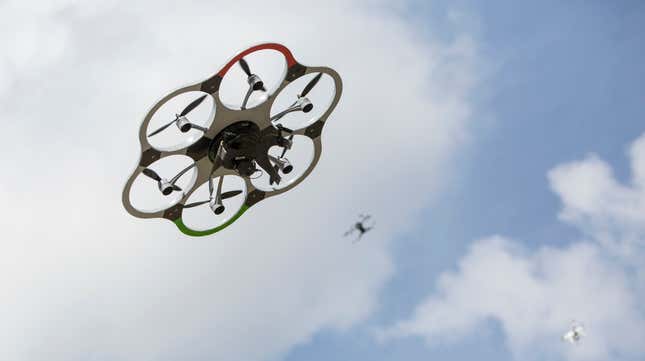
In partnership with the United Kingdom’s Strategic Command, which supports the Ministry of Defence, an unnamed company has developed a new battle-ready drone to assist armed forces with dangerous ground operations during urban warfare.
Reported by Popular Mechanics (via The Times), the i9 is a human-operated drone that can fly indoors, uses AI to locate and identify targets, and is outfitted with dual shotguns. If reading that makes you feel like we’re living in a 90s science fiction movie, well, I guess we are. Except Arnold is not headed to Mars.
As Popular Mechanics points out, breaching operations—when armed forces storm into a sealed off, enclosed area where enemy forces could be hiding—are one of the most dangerous type of ground operations. Casualties are usually high, especially among soldiers who enter the building first. Sending in a drone first is ideal for these kinds of operations. But hexacopters, or six-bladed drones like the i9, usually have issues with crashing to the ground if they get too close to a wall inside a small room, particularly if they are carrying something heavy, like a shotgun. The wall disrupts the airflow needed to keep the drone flying, which isn’t very useful in breaching operations.
The i9 is the UK’s first drone that can fly indoors while carrying heavy weaponry. The Ministry of Defence also hopes to develop other uses for the i9 as well, such as using it as a battering ram to knock other drones out of the sky and replacing the dual shotguns with either a rocket or chain gun. No, that is not the rambling of a video game designer. That is the desire of the UK’s Ministry of Defence.
Neither Popular Mechanics nor The Times went into detail about how the unnamed designers were able to achieve this, but apparently its AI element helps the drone balance itself mid-flight. Both also stressed that the i9 drone cannot choose to fire at what it deems a target on its own. A human operator has to manually tell the drone whether to fire or stand down.
In the US, Duke Robotics recently released a military UAS octocopter (eight-bladed) drone that can carry heavy firearms and “be used in various military applications including border patrol law enforcement, drone on drone warfare and counter terrorism.” (Yeah, that only sounds slightly terrifying.) Dubbed the Tikad drone, it won a security innovation award from the US Department of Defense in 2016. Like the i9 it too is remotely operated. That’s a good thing. Even though these drones are terrifying and dystopic, no armed drone should be given that much autonomy.
However, in a Human Rights Watch paper published recently, the US said lethal autonomous weapons “can have military and humanitarian benefits” during the August 2019 Convention on Conventional Weapons Group of Governmental Experts. The paper also noted that the UK previously said it considers existing international humanitarian law good enough to regulate the use of autonomous weapons.
According to the Campaign to Stop Killer Robots, the “US, China, Israel, South Korea, Russia, and the UK are developing weapons systems with significant autonomy in the critical functions of selecting and attacking targets.” The organization says fully autonomous weapons lack the necessary human judgement for these kinds of operations, and it could make the decision to go to war easier and “shift the burden of conflict even further on to civilians.” In a paper published last month, the organization lists 30 countries that have called for a prohibition on fully autonomous weapons—none of which include the UK or the US. However, in 2019 the Scottish National Party called for a ban on lethal autonomous weapons.
Warfare is horrible, and it’s understandable that any country would want its troops to return safely, but putting troops at both a literal and metaphorical distance from direct combat seems more akin to a videogame than anything else. And as the Campaign to Stop Killer Robots points out, these types of drones can pave the way for fully autonomous ones.